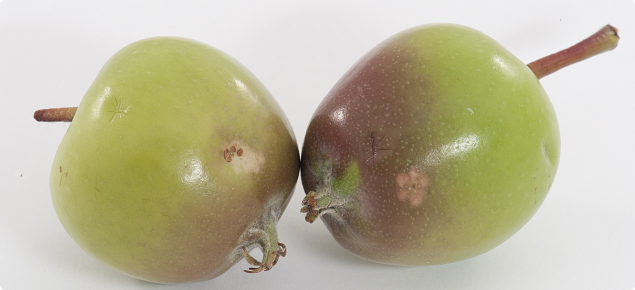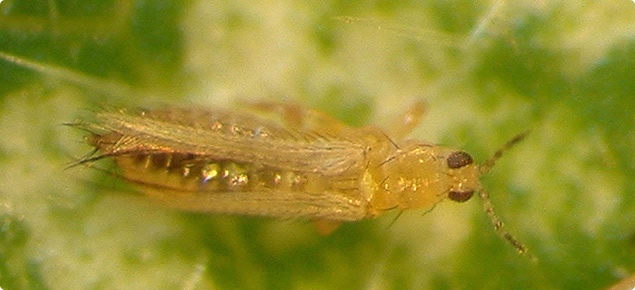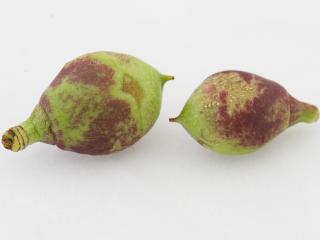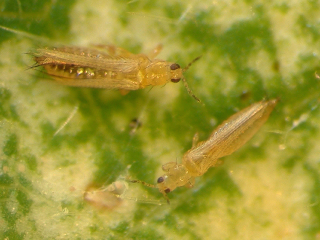Damage symptoms
Early season damage (flowering, fruiting)
- Scarring is caused by female thrips laying eggs into the buds and flowers of plums and nectarines. The larvae hatch and feed on the developing fruit of plums, nectarines, and peaches.
- Pansy spot. In apples, cherries, pears, and plums, oviposition damage causes ‘pansy spot’. The oviposition site becomes covered in scar tissue (<1mm in size), and is surrounded by a larger, pansy-shaped white discoloration. Similar damage has been observed in table grapes and French beans. Apples are particularly susceptible to pansy spot, with damage recorded from both green (Granny Smith) and red varieties (Pink Lady, Red Delicious, Rome Beauty, McIntosh), although some cultivars show no damage at harvest.
- Russeted spot. In pears, egg punctures result in a slightly depressed, russeted spot. At harvest this damage is characterised by russetting, scarring, pitting and/or scarred blotches.
- Dimpling. In plums, apples and cherries, dimples form as a result of differential growth between injured and uninjured tissue surrounding the oviposition site.
Late season damage
This occurs as the fruits ripen and is caused by adults and larvae feeding on the fruit surface, typically when the fruit has coloured.
- Silvering occurs as the fruit ripens and usually occurs in protected areas where thrips shelter, such as between touching fruit, where leaves contact the fruit, and at the stem end.
- Silvering is most obvious on highly coloured varieties of nectarine, and to a lesser extent, on cherries and peaches.
Other damage that may be confused with thrips
During seasons when the shuck remains on the developing fruit for longer and does not split, damage similar to that caused by thrips can occur. This can result in scarring and/or marking around the calyx, which becomes more obvious as the fruit grows in size. This type of damage can be distinguished from that caused by thrips in that there is no scarring or russetting.
A disorder termed russet scab has been reported from prunes in California when rain is heavy during bloom. As a result, there is incomplete development of the waxy layer, resulting in russetting.
Economic damage
Thrips damage can result in fruit being downgraded if it is scarred or russeted, or culled if fruit is misshapen.
Nectarines are most susceptible to thrips damage as the calyx adheres more tightly to developing fruit.
Thrips species
Four economically important thrips species are found in stone and pome fruit in Western Australia:
- western flower thrips (Frankliniella occidentalis)
- tomato thrips (Frankliniella schultzei)
- onion thrips (Thrips tabaci)
- plague thrips (Thrips imaginis).
All species are found throughout Australia except for western flower thrips (WFT), which is not present in the Northern Territory. For stone fruit, plague thrips are more likely to be a problem at flowering.
For apples, plague thrips and WFT may both be present at flowering. Although all species can cause silvering damage, WFT is the most important.
Thrips damage has been recorded from Gingin, the Perth Hills and Donnybrook/Manjimup.
Identification
Thrips are very difficult to identify without the aid of a microscope. If in doubt of an identification, send the specimens into DAFWA. The correct identification of WFT is most important, as it has developed resistance to a range of insecticides commonly used in orchards.
Sources of thrips
Surveys of orchards in the Perth Hills show that clover, plantain, fat hen, flatweed, capeweed and wireweed host the highest numbers of WFT. These weeds were most common in orchards and most likely to survive harsh summer conditions. WFT and other thrips can also be found in other species.
Plague thrips are a native species and can breed on native plants, particularly acacia (wattle) and eucalypts. They can be carried long distances on the wind.
Monitoring
- Start monitoring from budburst. Early in the season monitor by tapping buds and flowers into an icecream container. Most thrips found in August/September are likely to be plague thrips, with plague and WFT occurring later in the season (November-March).
- Blue sticky traps can also be used. As a rough guide, place five traps per hectare. Traps should be hung in the lower third of the tree and checked weekly.
- The addition of thrips lures such as Lurem and Thripline can further increase trap capture of WFT. Lurem will also increase capture of onion and plague thrips.
- As there appears to be no correlation between damage and the number of thrips caught on traps, direct inspections of flowers and fruit are still required.
- When trap catches indicate that thrips are present at critical periods (flowering/shuck fall, ripening), directly sample for thrips adults and their larvae.
Control
Weed control
- As weeds act as reservoirs for thrips, their management is essential. Thrips are particularly attracted to flowering weeds as they feed on the pollen.
- Be careful if you spray weeds with herbicide. As the weeds die off, thrips can move off the weeds onto your crop. You may want to treat weeds with insecticide at the same time.
- Mowing is another control option, though weeds in the drip line may escape control.
Biological control
- No biological controls are currently available for thrips control in orchards.
- Generalist predators such as lacewing and ladybird larvae may feed on thrips larvae.
Chemical control
- See the APVMA website for current recommendations.
- Chemical control of WFT can be problematic due to insecticide resistance. Correct identification of WFT is recommended for this reason.





